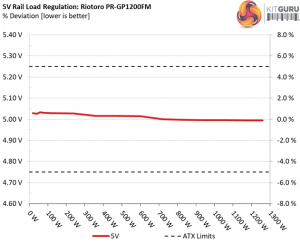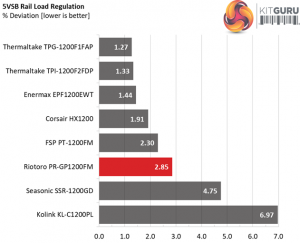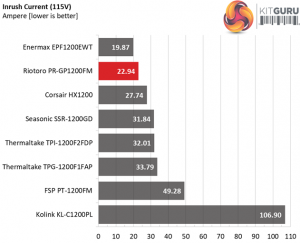To learn more about our PSU tests and methodology, please check out How We Test Power Supply Units.
Primary Rails And 5VSB Load Regulation
Load Regulation testing is detailed here.
Hold-Up Time
Our hold-up time tests are described in detail here.
The oscilloscope screenshots that we took during the hold-up time measurements:
Unfortunately the hold-up time is too small and to make matters even worse, the power ok signal is not accurate.
Inrush Current
For details on our inrush current testing, please click here.
The inrush current is low with both voltage inputs, given the unit's high capacity. Given the small capacity of the bulk caps and the proper inrush current protection, which usually is absent in High Power's platform, we didn't expect anything different here.
Load Regulation And Efficiency Measurements
The first set of tests reveals the stability of the voltage rails and the PR-GP1200FM’s efficiency. The applied load equals (approximately) 10 to 110 percent of the power supplies maximum load in increments of 10 percentage points.
We conducted two additional tests.
During the first, we stressed the two minor rails (5V and 3.3V) with a high load, while the load at +12V was only 0.1A. This test reveals whether a power supply is compatible with Intel’s C6/C7 sleep states or not. In the second test, we determined the maximum load the +12V rail could handle with minimal load on the minor rails.
| Test # | 12V | 5V | 3.3V | 5VSB | DC/AC (Watts) | Efficiency | Fan Speed (RPM) | PSU Noise (dB[A]) | Temps (In/Out) | PF/AC Volts |
| 1 | 8.173A | 1.988A | 1.979A | 1.002A | 119.969 | 89.536% | 753 | 18.3 | 40.07°C | 0.983 |
| 12.038V | 5.029V | 3.332V | 4.992V | 133.990 | 42.62°C | 115.10V | ||||
| 2 | 17.335A | 2.984A | 2.970A | 1.204A | 239.718 | 91.759% | 756 | 18.3 | 40.63°C | 0.995 |
| 12.046V | 5.027V | 3.332V | 4.983V | 261.247 | 43.82°C | 115.09V | ||||
| 3 | 26.855A | 3.489A | 3.460A | 1.410A | 359.226 | 91.878% | 1020 | 26.3 | 41.48°C | 0.996 |
| 12.036V | 5.016V | 3.322V | 4.964V | 390.980 | 45.49°C | 115.10V | ||||
| 4 | 36.448A | 3.988A | 3.971A | 1.615A | 479.681 | 91.783% | 1025 | 26.4 | 41.88°C | 0.998 |
| 12.031V | 5.016V | 3.323V | 4.956V | 522.626 | 46.65°C | 115.10V | ||||
| 5 | 45.641A | 4.987A | 4.966A | 1.820A | 599.831 | 91.285% | 1030 | 26.4 | 42.48°C | 0.998 |
| 12.036V | 5.014V | 3.322V | 4.947V | 657.095 | 49.35°C | 115.18V | ||||
| 6 | 54.927A | 6.001A | 5.960A | 2.031A | 719.937 | 90.133% | 1210 | 30.9 | 42.71°C | 0.998 |
| 12.019V | 5.000V | 3.322V | 4.926V | 798.747 | 49.50°C | 115.18V | ||||
| 7 | 64.085A | 7.004A | 6.956A | 2.238A | 839.705 | 89.303% | 1525 | 38.0 | 43.51°C | 0.999 |
| 12.025V | 4.998V | 3.321V | 4.916V | 940.290 | 51.02°C | 115.09V | ||||
| 8 | 73.251A | 8.008A | 7.951A | 2.446A | 960.138 | 88.477% | 1530 | 38.0 | 43.73°C | 0.999 |
| 12.037V | 4.996V | 3.320V | 4.906V | 1085.184 | 51.50°C | 115.09V | ||||
| 9 | 82.776A | 8.509A | 8.431A | 2.446A | 1079.501 | 87.445% | 1700 | 40.6 | 44.81°C | 0.999 |
| 12.044V | 4.996V | 3.321V | 4.906V | 1234.492 | 54.82°C | 115.09V | ||||
| 10 | 92.276A | 9.011A | 8.945A | 3.075A | 1200.011 | 86.270% | 1715 | 40.8 | 45.34°C | 0.999 |
| 12.032V | 4.995V | 3.320V | 4.879V | 1390.997 | 59.07°C | 115.10V | ||||
| 11 | 97.377A | 9.011A | 8.957A | 3.071A | 1259.722 | 86.507% | 1695 | 40.6 | 28.37°C | 0.999 |
| 12.015V | 4.994V | 3.316V | 4.886V | 1456.200 | 42.37°C | 115.09V | ||||
| CL1 | 0.142A | 16.001A | 16.000A | 0.000A | 135.073 | 83.302% | 760 | 18.4 | 40.11°C | 0.984 |
| 12.068V | 5.020V | 3.316V | 5.029V | 162.149 | 50.09°C | 115.12V | ||||
| CL2 | 89.297A | 1.001A | 0.998A | 1.000A | 1086.254 | 87.932% | 1690 | 40.5 | 29.85°C | 0.999 |
| 12.015V | 5.003V | 3.318V | 4.971V | 1235.336 | 41.13°C | 115.10V |
When tested at up to 50% load, the fan spins at low speeds, hence the unit's noise is kept low. It starts to get noticeable in the next test and in the worst case scenario it barely exceeds 40 dB(A). The fan profile is not aggressively tuned, that's for sure, since even with full load at 45°C it doesn't allow the fan to spin at its full speed.
Unfortunately the PSU isn't able to deliver 110% of its full power but it can go up to 105% only (1260W) and this is at normal operating temperatures and not >40°C. It isn't also able to deliver more than 90 Amps on the +12V rail during the CL2 test, although its paper specifications mention about 100A on this rail. Those facts lead us to believe that High Power was super conservative with the over power and over current protection features.
With 20% and 50% of its max-rated capacity the unit meets the 80 PLUS Gold standard's requirements, but with full load it fells short. Nonetheless, we apply much more stress than 80 PLUS since we test with higher temperatures, so efficiency takes a hit.
The load regulation is very tight on all rails, especially at +12V which is the most important rail.
 KitGuru KitGuru.net – Tech News | Hardware News | Hardware Reviews | IOS | Mobile | Gaming | Graphics Cards
KitGuru KitGuru.net – Tech News | Hardware News | Hardware Reviews | IOS | Mobile | Gaming | Graphics Cards



















